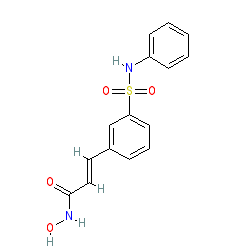|
Synonyms: Beleodaq® | PXD-101 | PXD101
belinostat is an approved drug (FDA (2014))
Compound class:
Synthetic organic
Ligand Activity Visualisation ChartsThese are box plot that provide a unique visualisation, summarising all the activity data for a ligand taken from ChEMBL and GtoPdb across multiple targets and species. Click on a plot to see the median, interquartile range, low and high data points. A value of zero indicates that no data are available. A separate chart is created for each target, and where possible the algorithm tries to merge ChEMBL and GtoPdb targets by matching them on name and UniProt accession, for each available species. However, please note that inconsistency in naming of targets may lead to data for the same target being reported across multiple charts. ✖
View more information in the IUPHAR Pharmacology Education Project: belinostat |
|
|||||||||||||||||||||||||||||||||||
| No information available. |
Mechanism Of Action and Pharmacodynamic Effects  |
| Belinostat is a hydroxamate-type HDAC inhibitor which induces apoptosis in vitro [2,4-6] thereby reducing tumour load. HDACs function as integral components of multi-protein complexes which are recruited to specific regions of the genome. These protein complexes control the expression and silencing (repression) of specific sets of genes which provides the basis for the reported phenotypes typical of malignant cancer cells. HDAC inhibition causes transcriptional de-repression of genes modulating growth inhibition, differentiation and apoptosis of cancer cells. |
External links  |
|
For extended ADME data see the following: Drugs.com European Medicines Agency (EMA) |








